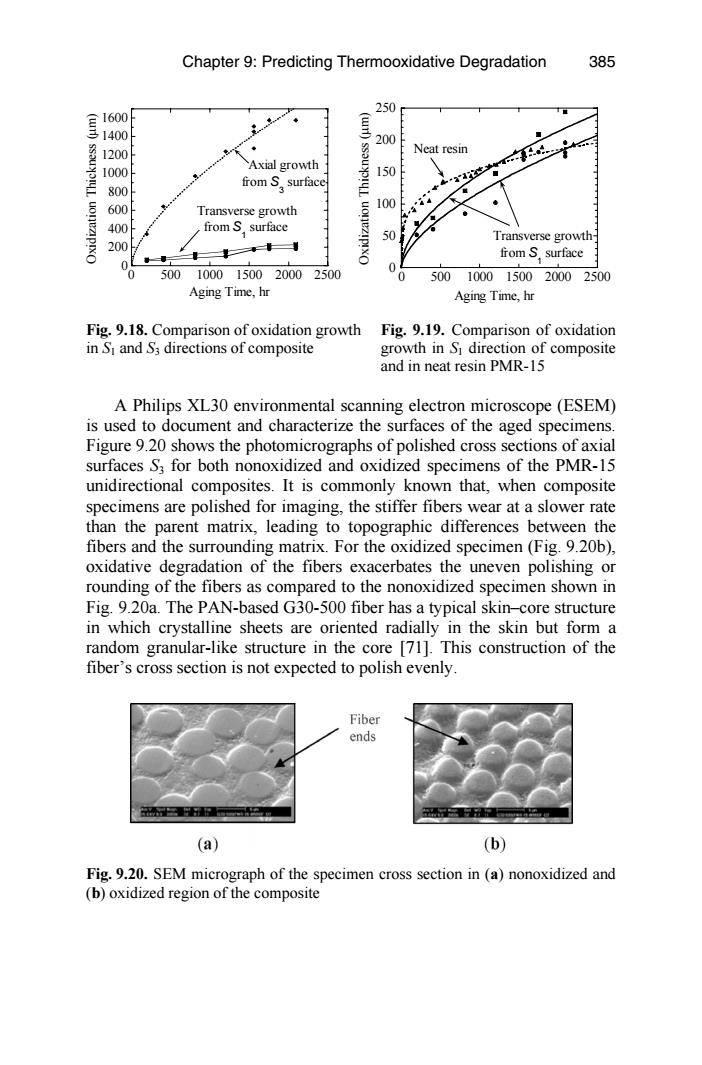正在加载图片...

Chapter 9:Predicting Thermooxidative Degradation 385 250 () 1600 1400 200 1200 Neat resin 1000 Axial growth 150 x沙指 800 from S surface 目 600 Transverse growth 100 400 from S.surface uoneziplxO y 50 Transverse growth 200 一一 from S,surface 0 5001000150020002500 5001000150020002500 Aging Time,hr Aging Time,hr Fig.9.18.Comparison of oxidation growth Fig.9.19.Comparison of oxidation in S and S3 directions of composite growth in S direction of composite and in neat resin PMR-15 A Philips XL30 environmental scanning electron microscope (ESEM) is used to document and characterize the surfaces of the aged specimens Figure 9.20 shows the photomicrographs of polished cross sections of axial surfaces S3 for both nonoxidized and oxidized specimens of the PMR-15 unidirectional composites.It is commonly known that,when composite specimens are polished for imaging,the stiffer fibers wear at a slower rate than the parent matrix,leading to topographic differences between the fibers and the surrounding matrix.For the oxidized specimen (Fig.9.20b), oxidative degradation of the fibers exacerbates the uneven polishing or rounding of the fibers as compared to the nonoxidized specimen shown in Fig.9.20a.The PAN-based G30-500 fiber has a typical skin-core structure in which crystalline sheets are oriented radially in the skin but form a random granular-like structure in the core [71].This construction of the fiber's cross section is not expected to polish evenly Fiber ends (a) (b) Fig.9.20.SEM micrograph of the specimen cross section in(a)nonoxidized and (b)oxidized region of the compositein S1 and S3 directions of composite growth in S1 direction of composite and in neat resin PMR-15 A Philips XL30 environmental scanning electron microscope (ESEM) is used to document and characterize the surfaces of the aged specimens. surfaces S3 for both nonoxidized and oxidized specimens of the PMR-15 unidirectional composites. It is commonly known that, when composite specimens are polished for imaging, the stiffer fibers wear at a slower rate than the parent matrix, leading to topographic differences between the fibers and the surrounding matrix. For the oxidized specimen (Fig. 9.20b), oxidative degradation of the fibers exacerbates the uneven polishing or rounding of the fibers as compared to the nonoxidized specimen shown in Fig. 9.20a. The PAN-based G30-500 fiber has a typical skin–core structure in which crystalline sheets are oriented radially in the skin but form a random granular-like structure in the core [71]. This construction of the fiber’s cross section is not expected to polish evenly. Fig. 9.20. SEM micrograph of the specimen cross section in (a) nonoxidized and (b) oxidized region of the composite 0 50 100 150 200 250 0 500 1000 1500 2000 2500 Oxidization Thickness (µm) Aging Time, hr Neat resin Transverse growth from S1 surface 0 200 400 600 800 1000 1200 1400 1600 0 500 1000 1500 2000 2500 Oxidization Thickness (µm) Aging Time, hr Axial growth from S3 surface Transverse growth from S1 surface Figure 9.20 shows the photomicrographs of polished cross sections of axial Fig. 9.18. Comparison of oxidation growth Fig. 9.19. Comparison of oxidation Chapter 9: Predicting Thermooxidative Degradation 385